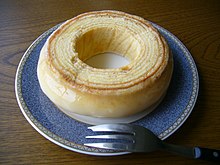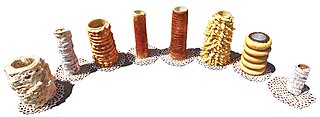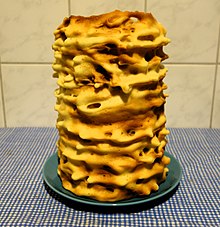Baumkuchen

The Baumkuchen is a cake made of sand and built up in layers and baked over an open flame . The "king of cakes" is a symbol of the confectionery profession (professional or guild emblem ).
history
The exact time of the invention of the tree cake is not known, but in the Middle Ages there were also breads in which the dough was wrapped around a skewer and roasted over the fire (still known today as stick bread or stick dough ).
It is believed by some historians that the tree cake is of Hungarian origin. It was a kind of wedding cake and quickly found its way into German cuisine. Others claim, however, that a similar shape was already known to the ancient Greeks .
The first recipes for the cake are in an Italian cookbook from 1426. The term "Baumkuchen" ( Latin placentae cylindricae ) was first used in 1682 in a dietary cookbook by Johann Sigismund Elsholtz , the personal physician to Elector Friedrich Wilhelm of Brandenburg . Because of its similar shape, the tree slice is often mistakenly called a tree cake. The oldest surviving German-language recipe appeared around 1450 in a Heidelberg manuscript. In Nuremberg and Frankfurt am Main , Baumkuchen was a well-known wedding cake for patricians as early as the 15th century .
In the 16th century the production method changed; the cake dough was no longer placed in a ring around a rotating wooden roller, but tied as a whole piece and with strings. The typical notches of the tree cake were created by the setting. In the 17th century, another new manufacturing method emerged, in which thin dough was poured in layers onto the rotating roller. It was also at this time that it became common to apply a glaze of sugar and rose water . At that time, sugar was still used sparingly in the preparation of dough; nutmeg , cinnamon and cardamom were used for seasoning .
The recipe that is common today was not created until the 18th century. One of the first known recipes of this new type is contained in the 7th edition of the Nieder-Sächsischer Koch-Buch from 1769 (see also 10th edition from 1776). At that time, the finished tree cake was sprinkled with grated chocolate or coated entirely with couverture . Since around 1800 these cakes were hardly made in private households, but almost exclusively by confectioners . Baumkuchen production focuses on Dresden , Cottbus and Salzwedel . Salzwedeler Baumkuchen has had the EU quality mark Protected Geographical Indication (PGI) since 2010 .
In Japan , where it was brought by the German confectioner Karl Joseph Wilhelm Juchheim , the Baumkuchen ( バ ウ ム ク ー ヘ ン Baumukūhen or バ ー ム ク ー ヘ ン Bāmukūhen ) is one of the most popular baked goods of all and despite its relatively high price, at least packaged available in almost every grocery store.
Manufacturing
The ingredients of a Baumkuchen mass are butter, eggs, sugar, vanilla , salt and flour. Baking soda must not be used. The ratio of flour, butter and eggs must be at least 1: 1: 2, i.e. 100 g of flour must contain at least 100 g of butter and 200 g of whole egg. Honey and alcohol (for example rum ) can be added as flavors, as can nuts, marzipan and nougat . The basic recipe is always the same.
A real tree cake is baked in layers on a rotating skewer , the so-called roller. In the past, this was done over a wood fire, today there are specially designed baking appliances that are heated electrically or with gas. The dough is applied in around 10 to 20 individual layers, usually by dipping, and baked in layers. As a result, the layers in the finished cake resemble the annual rings on a tree.
A special technique when applying the individual layers of dough (shaping with a wooden comb) gives the cake a wavy contour, and rings are formed. After removing the skewer, the cake roll can be cut into portions, one to five rings are common. These are glazed with fondant or couverture (either dark chocolate or milk chocolate). The long baking time makes the Baumkuchen very long-lasting and enables it to be exported to Japan and the USA. However, this is only possible as a blank, because a glaze can, under certain circumstances, significantly shorten its shelf life as it attracts moisture.
For consumption, Baumkuchen is traditionally made with roughly spiral-shaped cuts in “clods” no more than a quarter rib thick, always gradually in a circle from top to bottom. Another type of cut is to cut off individual rings and then, depending on the size of the rings, quarter or eighth. The individually baked layers are visible. The vertical cuts that are common with other types of cake are not common with Baumkuchen.
To make the Baumkuchen tips, a ring is cut into trapezoidal pieces that are individually coated with glaze. According to another method, which is more common, the mass is spread in layers on a baking sheet, baked and cut after cooling. This means that large quantities can be produced quickly. The pointed cake has no curvature and is therefore more even.
In Greece he is called Obelisa , in Romania Agnethler .
Similar cakes
- In Austria : “Brandenberger Prügeltorte” with characteristic tips. Terms such as “whipping cake”, “skewer cake” or “whipping donut” are also used, as the dough is layered very thinly around the baking wood, i.e. a beating.
- In Denmark and Norway : Kransekage
- In Sweden : Spettekaka
- In Transylvania : Baumstriezel ( Hungarian: Kürtőskalács )
- In Slovakia : Trdelník
- In Lithuania : Šakotis . It is a traditional specialty in Lithuania as well as in the north-eastern regions ( Podlachia and Mazury ) of Poland ( Polish name: sękacz ), where it has been valued nationwide by the nobility since the 16th century and is well known today.
- In France : Gâteau à la broche
- In Japan : Baumukūhen バ ウ ム ク ー ヘ ン (from German Baumkuchen )
literature
- Irene Krauss : Chronicle of beautiful baked goods . Matthaes, Stuttgart 1999, ISBN 978-3-87516-292-9
Web links
Individual evidence
- ↑ Friedrich Holtz a. a .: Textbook of the pastry shop . 5th edition. Trauner, Linz 2009, ISBN 978-3-85499-367-4 , pp. 321 f .
- ↑ 1 stick bread recipe. Retrieved December 16, 2018 .
- ↑ Alan Davidson and Tom Jaine (2006). The Oxford companion to food . Oxford University Press, USA, 2006. pp. 805, ISBN 0-19-280681-5 .
- ↑ Stanley Cauvain and Linda Young (2001). Baking problems solved . Woodhead Pub Ltd, p. 261. ISBN 0-8493-1221-3 .
- ^ Johann Sigismund Elsholtz: Diaeteticon . Cölln an der Spree 1682, p. 272
- ↑ a b c Irene Krauss : Chronicle of beautiful baked goods . Stuttgart 1999, p. 184 ff.
- ↑ Marcus Loofft: Nieder-Sächsisches Koch-Buch . 10th edition. Lübeck 1776; Baumkuchen recipe, p. 430 (digital copy from the University of Göttingen)
- ↑ Altmark specialty Salzwedeler Baumkuchen is baked over the fire . In: Mitteldeutsche Zeitung ; Retrieved April 19, 2016
- ↑ Thomas Hahn, Verena Mayer: Lord of the Rings - How a German confectioner made the tree cake the favorite of the Japanese. sueddeutsche.de, December 24, 2019, accessed December 25, 2018 .
- ↑ Principles for fine baked goods. BMELV download page
- ↑ Cottbus Baumkuchen Manufaktur , accessed on April 19, 2016
- ↑ Brandenburger beatings cake
- ↑ Anja Hankel: Loanwords in Japanese . TOPIA. November 2009. Archived from the original on July 22, 2011.




